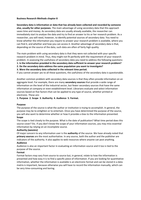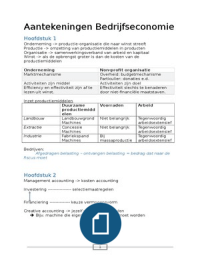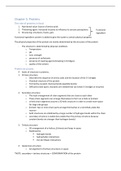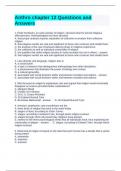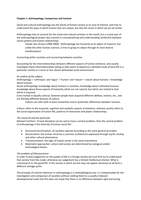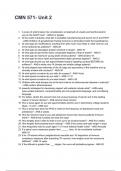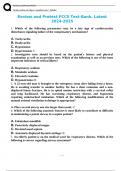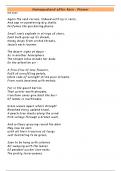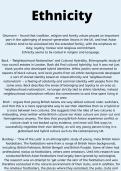Business Research Methods chapter 8
Secondary data is information or data that has already been collected and recorded by someone
else, usually for other purposes. The main advantage of using secondary data that this approach
saves time and money. As secondary data are usually already available, the researcher can
immediately start to analyse the data and try to find an answer to his or her research problem. As a
researcher, you will need, however, to identify potential sources of secondary data. You need to
know whether the information you require to answer your research problem is available, where you
can find it, and whether and how you can access it. Another advantage of secondary data is that,
depending on the source of the data, such data are often of fairly high quality.
The main problem with using secondary data is that they were not collected with your specific
research problem in mind. Thus, they might not fit perfectly with the requirement of your research
problem. In assessing the usefulness of secondary data you need to address the following questions:
1. Is the information provided in the secondary data sufficient to answer your research problem?
2. Do the secondary data address the same population you want to investigate?
3. Were the secondary data collected in the relevant time period.
If you cannot answer yes to all these questions, the usefulness of the secondary data is questionable.
Another common problem with secondary data sources is that they often provide information on an
aggregate level. For example, there are many secondary sources that provide a wide range of
information on the level of the industrial sector, but fewer secondary sources that have the same
information at company or even establishment level. Librarians evaluate and select information
sources based on five factors that can be applied to any type of source, whether printed or
electronic. These are:
1. Purpose 2. Scope 3. Authority 4. Audience 5. Format.
Purpose
The purpose of the source is what the author or institution is trying to accomplish. In general, the
purpose may be to enlighten or to entertain. Once you have determined the purpose of the source,
you will also want to determine whether or how it provides a bias to the information presented.
Scope
The scope is tied closely to the purpose. What is the date of publication? What time period does this
source cover? Etc. If you don’t know the scope of your information sources, you may miss essential
information by relying on an incomplete source.
Authority (aanzien)
Of major concern to any information user is the authority of the source. We have already noted that
primary sources are the most authoritative. In any source, both the author and the publisher are
indicators of the authority. It also applies to web resources where anyone can post anything.
Audience
Audience is also an important factor in evaluating an information source and it too is tied to the
purpose of the source.
Format
Format factors may vary from source to source but, in general, relate to how the information is
presented and how easy it is to find a specific piece of information. If you are looking for quantitative
information, whether the information is available is an electronic format and can be stored in a data
matrix is important, because otherwise you will have to record the information manually, which can
be very time-consuming and boring.
Secondary data is information or data that has already been collected and recorded by someone
else, usually for other purposes. The main advantage of using secondary data that this approach
saves time and money. As secondary data are usually already available, the researcher can
immediately start to analyse the data and try to find an answer to his or her research problem. As a
researcher, you will need, however, to identify potential sources of secondary data. You need to
know whether the information you require to answer your research problem is available, where you
can find it, and whether and how you can access it. Another advantage of secondary data is that,
depending on the source of the data, such data are often of fairly high quality.
The main problem with using secondary data is that they were not collected with your specific
research problem in mind. Thus, they might not fit perfectly with the requirement of your research
problem. In assessing the usefulness of secondary data you need to address the following questions:
1. Is the information provided in the secondary data sufficient to answer your research problem?
2. Do the secondary data address the same population you want to investigate?
3. Were the secondary data collected in the relevant time period.
If you cannot answer yes to all these questions, the usefulness of the secondary data is questionable.
Another common problem with secondary data sources is that they often provide information on an
aggregate level. For example, there are many secondary sources that provide a wide range of
information on the level of the industrial sector, but fewer secondary sources that have the same
information at company or even establishment level. Librarians evaluate and select information
sources based on five factors that can be applied to any type of source, whether printed or
electronic. These are:
1. Purpose 2. Scope 3. Authority 4. Audience 5. Format.
Purpose
The purpose of the source is what the author or institution is trying to accomplish. In general, the
purpose may be to enlighten or to entertain. Once you have determined the purpose of the source,
you will also want to determine whether or how it provides a bias to the information presented.
Scope
The scope is tied closely to the purpose. What is the date of publication? What time period does this
source cover? Etc. If you don’t know the scope of your information sources, you may miss essential
information by relying on an incomplete source.
Authority (aanzien)
Of major concern to any information user is the authority of the source. We have already noted that
primary sources are the most authoritative. In any source, both the author and the publisher are
indicators of the authority. It also applies to web resources where anyone can post anything.
Audience
Audience is also an important factor in evaluating an information source and it too is tied to the
purpose of the source.
Format
Format factors may vary from source to source but, in general, relate to how the information is
presented and how easy it is to find a specific piece of information. If you are looking for quantitative
information, whether the information is available is an electronic format and can be stored in a data
matrix is important, because otherwise you will have to record the information manually, which can
be very time-consuming and boring.


